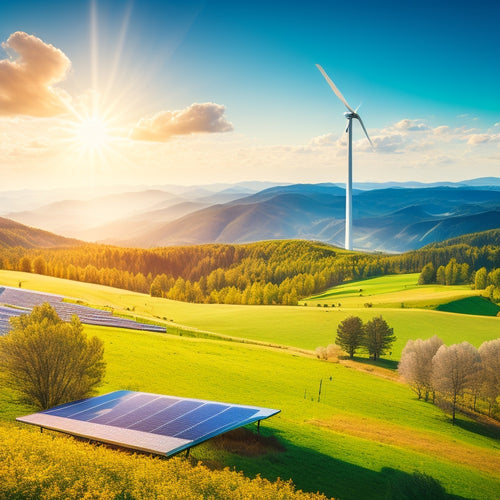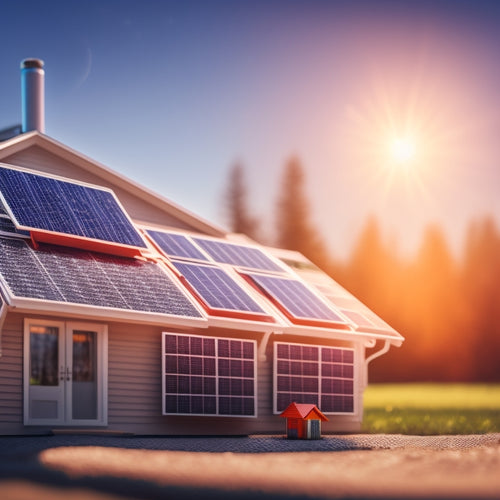
What's Draining Your Home's Energy Efficiency?
Share
You're likely wasting up to 30% of your home's energy due to hidden inefficiencies, with culprits like air leaks, outdated appliances, and poor insulation secretly draining your energy budget. Energy audits can help identify these hidden energy wasters, highlighting inefficiencies in appliances, lighting, and HVAC systems. Insulation issues, air leaks, and window inefficiencies can also contribute to energy losses. Regular filter maintenance, duct inspections, and appliance upgrades can help optimize energy efficiency. By addressing these common energy drains, you can lower your energy bills and reduce your carbon footprint - and there's more to investigate to maximize your energy savings.
Overview
- Hidden energy wasters in appliances, lighting, and HVAC systems can be identified through smart home energy audits, revealing opportunities for improvement.
- Insulation inadequacies and air leaks in windows and doors can lead to significant energy losses, emphasizing the need for regular inspection and sealing.
- Inefficient windows with high U-factors and SHGC values can be improved with window films, reducing heat gain and energy consumption.
- Neglecting HVAC system maintenance, including filter replacements and duct sealing, can lead to increased energy bills and system breakdowns.
- Inefficient lighting and appliances, such as incandescent bulbs and old kitchen appliances, can be upgraded to energy-efficient alternatives like LEDs and ENERGY STAR-certified products.
Identify Hidden Energy Wasters
Because energy consumption patterns can be complex, pinpointing areas of inefficiency in your home can be an intimidating task. However, by conducting an energy audit, you can identify hidden energy wasters and take control of your energy consumption.
Shifting to renewable energy sources renewable energy benefits not only reduces your carbon footprint but also leads to substantial savings. A smart home energy audit uses advanced tools to detect energy losses, providing a detailed report of your home's energy usage.
This report highlights areas of inefficiency, such as appliances, lighting, and HVAC systems, allowing you to prioritize energy-saving upgrades. By identifying and addressing these hidden energy wasters, you can optimize your home's energy efficiency, reduce your energy bills, and enjoy the freedom that comes with being in control of your energy consumption.
Assess Your Insulation Situation
Frequently, homeowners overlook a vital aspect of home energy efficiency: insulation. You might think you have adequate insulation, but it's important to evaluate your situation.
Conducting a thorough energy audit, like evaluating energy needs and sizing an energy storage system, can help identify areas of inefficiency in your home.
Load profiling can also reveal patterns of energy usage that may indicate inadequate insulation. Check your attic, walls, and floors for insulation materials with high thermal resistance. This will help reduce heat transfer and keep your home warm in the winter and cool in the summer.
Insulation materials like fiberglass, cellulose, and spray foam have varying thermal resistance values, so it's important to choose the right one for your climate and budget.
Don't assume your insulation is doing its job; inspect it regularly to confirm it's not damaged, wet, or settling.
Proper insulation can greatly reduce your energy consumption and save you money on utility bills.
Check for Air Leaks Everywhere
You'll want to seal window gaps tightly, as even the smallest openings can let heated or cooled air escape.
Inspect door seams closely, paying attention to the areas where the door meets the frame, as these spots are common culprits for air leaks.
In off-grid homes, high-efficiency solar charging solutions are essential to minimize energy loss and maximize energy autonomy.
Seal Window Gaps Tight
Sealing window gaps tight is an essential step in preventing heat from escaping and reducing your energy bills. You can achieve this by employing effective window sealing techniques.
Start by inspecting your windows for gaps and cracks. Then, apply energy-efficient materials like caulk, weatherstripping, or spray foam to seal the openings. Make sure to choose materials that are compatible with your window frames and sashes.
Additionally, consider replacing old or worn-out windows with new, energy-efficient ones. By sealing window gaps tight, you'll be able to retain warmth in the winter and cool air in the summer, ultimately leading to significant energy savings and a more comfortable living space.
Inspect Door Seams Closely
As you shift your attention from windows to doors, careful inspection is essential to detecting air leaks that can undermine your energy efficiency efforts. Check the door seams closely for any gaps or cracks, as these can let warm air escape and cold air seep in.
| Door Weatherstripping Options | Energy Efficient Materials |
|---|---|
| Felt | Fiberglass |
| Foam Tape | Vinyl |
| Threshold Seal | Rubber |
Choose from a variety of door weatherstripping options to find the best fit for your door type and climate. Look for energy efficient materials that provide a tight seal and can withstand temperature fluctuations. By inspecting door seams closely, you can identify and address air leaks, ultimately reducing energy waste and saving you money on your utility bills.
Evaluate Window Energy Efficiency
When it comes to evaluating window energy efficiency, take a closer look at the numbers.
Check the energy ratings of your windows, which indicate how well they insulate and reduce heat transfer. A lower U-factor means better insulation, while a lower solar heat gain coefficient (SHGC) reduces heat gain during summer.
Consider applying window films to improve energy efficiency. These films can reduce heat gain by up to 80% and keep warmth in during winter.
Look for films with a low SHGC and high visible transmittance to minimize impact on your view.
Investigate Your HVAC System
You'll want to inspect your HVAC system to identify areas for improvement, starting with regular filter maintenance to prevent airflow restrictions and system strain.
Next, you'll need to check for leaks and duct issues, as these can lead to significant energy losses and decreased system performance.
Additionally, understanding the system's efficiency rating will help you determine whether it's time to contemplate upgrading to a more energy-efficient model.
Filter Maintenance Required
Your heating, ventilation, and air conditioning (HVAC) system relies heavily on an essential yet easily overlooked component: the air filter. There are several types of filters, including fiberglass, pleated, and high-efficiency particulate air (HEPA) filters, each with its own benefits.
Regular filter maintenance is vital to guarantee your HVAC system operates efficiently and effectively. A clean filter helps improve indoor air quality, reduces energy consumption, and prolongs the system's lifespan.
Neglecting filter maintenance can lead to increased energy bills, reduced airflow, and even system breakdowns. By replacing your air filter every 1-3 months, you'll enjoy the benefits of a well-maintained HVAC system, including energy savings and a healthier living environment.
Leaks and Duct Issues
Dig into your HVAC system to uncover hidden energy wasters: leaks and duct issues.
Leaks in your ductwork can cause heated or cooled air to escape, forcing your system to work harder and increasing your energy bills. You'll need to inspect your ducts for gaps, cracks, and disconnections. Duct sealing can help resolve this issue.
Additionally, an imbalance in ventilation can also reduce energy efficiency. If your system isn't properly balanced, some areas of your home may receive too much air while others receive too little. Achieving ventilation balance is essential to guarantee that your system operates efficiently.
Efficiency Rating Matters
The efficiency rating of your HVAC system plays an essential role in determining its energy consumption and overall performance. You should investigate your system's rating to verify it's not draining your home's energy efficiency.
Look for energy labels like the ENERGY STAR certification, which indicates that your system meets energy efficiency standards set by the U.S. Environmental Protection Agency. Check the system's SEER (Seasonal Energy Efficiency Ratio) rating, which measures its cooling efficiency, and the AFUE (Annual Fuel Utilization Efficiency) rating, which measures its heating efficiency. Higher ratings indicate higher efficiency.
Confirm your system has efficiency certifications from organizations like the Air-Conditioning, Heating, Refrigeration Certification Board (ACHR). By understanding your system's efficiency rating, you can identify opportunities to improve its performance and reduce energy consumption.
Examine Lighting Energy Usage
About 15% of a typical household's energy consumption is attributed to lighting, making it a significant contributor to overall energy usage. You can't ignore the impact lighting has on your home's energy efficiency.
When you examine your lighting energy usage, consider the type of bulbs you're using. Incandescent bulbs waste energy as heat, while LED bulbs offer significant energy savings.
LED benefits include longer lifetimes, reduced maintenance, and lower energy costs. Investigate lighting alternatives, such as smart bulbs that can be controlled remotely, to optimize your lighting energy usage.
Review Appliance Energy Consumption
Since you likely spend a considerable amount of time in your kitchen, it's essential to review appliance energy consumption, as this area is often a hotspot for energy usage.
Take inventory of your appliances' energy consumption by checking their EnergyGuide labels or ENERGY STAR certifications. Identify which appliances are draining the most energy and consider replacing them with energy efficient alternatives.
Appliance upgrades, such as switching to LED refrigerators or energy-efficient dishwashers, can greatly reduce your energy consumption.
Analyze your usage patterns to determine which appliances are used most frequently and prioritize upgrades accordingly.
Frequently Asked Questions
How Does Energy Efficiency Impact My Home's Resale Value?
You enhance your home's resale value by investing in energy audits, which highlight efficiency upgrades, appealing to eco-conscious buyers and aligning with current resale trends, ultimately increasing your property's attractiveness and sale price.
Are Energy-Efficient Upgrades Worth the Upfront Cost?
When assessing energy-efficient upgrades, you're likely wondering if the initial investment is worth it; however, consider the long-term savings, which can offset the cost, and ultimately, give you the freedom to allocate resources as you see fit.
Can I Make Energy-Efficient Changes as a Renter?
As you weigh your eco-friendly options, remember you're not handcuffed by renting - you can still make a difference! Overcome renter challenges by exploring DIY improvements, like swapping light bulbs, using power strips, and adjusting your thermostat to maximize energy efficiency.
What Is the Average Energy Savings From Energy-Efficient Upgrades?
You'll typically save 10-30% on energy bills after upgrades, but it depends on your home's specific needs, which an energy audit can identify; cost comparisons will help you prioritize the most effective changes for your budget and goals.
Do Energy-Efficient Homes Require More Maintenance?
You'll find that energy-efficient homes don't necessarily require more maintenance, but they do benefit from regular preventive maintenance and occasional energy audits to guarantee peak performance and maximize your energy savings over time.
Ready to Buy
You've tackled the energy-sucking culprits in your home, and now you're well on your way to saving a small fortune on your utility bills. By identifying hidden energy wasters, evaluating insulation, and checking for air leaks, you've plugged the holes in your energy bucket. Your windows, HVAC system, lighting, and appliances are all humming along efficiently. With these tweaks, you've fundamentally changed your home into an energy-saving superhero, saving you a gazillion dollars in the long run!
Related Posts
-

Renewable Energy Solutions to Reduce Your Carbon Footprint
To reduce your carbon footprint, adopting renewable energy solutions is key. Using solar panels or wind turbines can ...
-

A Beginner's Guide to Navigating the Solar Investment Tax Credit
You're eligible to claim a significant Solar Investment Tax Credit (ITC) of 30% of total installation costs, but mane...
-
Average Lifespan of Solar Battery Banks
The average lifespan of solar battery banks generally ranges from 5 to 15 years. This variation mainly stems from the...

